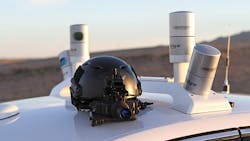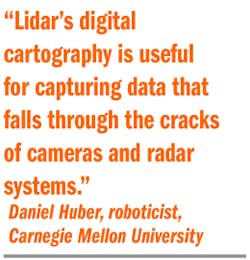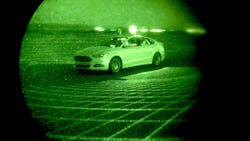For more than 20 years, David Hall rarely crossed paths with giant automakers like Ford and General Motors. Velodyne, which he founded in 1983, stayed focused on its business of subwoofers, speakers, and other acoustic accouterments.
But that changed when Velodyne built its first laser-based radars for an autonomous car race, sponsored by the Defense Advanced Research Projects Agency, across the Mojave Desert in 2005. Now the automotive industry is one of Velodyne’s closest confidants.
That relationship tightened last week when the company raised $150 million in funding to develop better laser imaging technology or lidar for driverless cars. Velodyne’s lidar works with cameras and radar to gather data about the vehicle’s surroundings and keep an eye on traffic and pedestrians.
Ford and China’s search engine company Baidu led the funding round with two $75 million investments. Both companies are testing autonomous cars with Velodyne’s sensors mounted on the roof to silently watch the road. Ford’s vehicles, for instance, are arrayed with thorn-like lidars, which spin constantly and spray laser beams in every direction. The sensors capture the reflected signals and send them into on-board computers, which create an instantaneous 3D map of the environment.
“From the very beginning of our autonomous vehicle program, we saw lidar as key enabler due to its sensing capabilities and how it complements radar and cameras,” said Raj Nair, Ford’s vice president of product development, in a statement.
But the lidar’s mesmerizing accuracy is not only altering the automotive industry. Earlier this year, for example, archeologists used lidar to discover roads and irrigation ditches around the ancient Cambodian city of Angkor Wat, whose remains were too worn down for normal cameras to see. Caterpillar, the construction equipment maker, is using Velodyne’s lidar for mapping quarries, work sites, and farms.
Velodyne said that the funds will be used to hire new engineers and expand manufacturing, with an eye toward reducing the cost of its technology, which can fetch tens of thousands of dollars per system. David Hall, Velodyne’s founder and chief executive, said that these are necessary steps toward making lidar “widely accessible and enabling mass deployment of fully autonomous vehicles.”
Aside from the engineering problems with autonomous driving, the lidar’s cost is one of the obstacles to releasing fleets of driverless cars. In 2012, Google said that the equipment on its cars cost around $150,000 and almost half of that was poured into Velodyne’s lidar system. Today, Google's project use Velodyne lidars that cost roughly $8,000.
“We want the cost to be low enough to be used for all cars,” said Marta Hall, Velodyne’s president of business development, in a statement.
The funding is the latest validation of Velodyne's lidar sensors, which were first used in autonomous driving experiments a decade ago. In 2007, almost all the cars that finished the DARPA Urban Challenge, another race for driverless cars, used Velodyne’s lidar to navigate a simulated city.
Lidar’s digital cartography is useful for capturing data that falls through the cracks of cameras and radar systems, said Daniel Huber, a roboticist at Carnegie Mellon University, in an interview with Electronic Design following the accident. “Getting cars to drive on cameras alone would be the equivalent to solving artificial intelligence,” Huber said.
Cameras have difficulty seeing at night and in bad weather conditions like rain, fog, and snow. Radars, on the other hand, can accurately track the movement of cars over a long distance, but they have trouble calculating the size and shape of objects, like road signs, road construction equipment, and cars.
Lidar is one way to make sure less data escapes the car’s view. It can not only measure the distance to other cars and obstacles, Huber said, it can also determine size and shape. It has also been used successfully for autonomous driving at night and in snowy weather.
To drive on unpredictable roads, lidar absorbs huge amounts of data from its surroundings and filters it into a vehicle’s on-board computers. Velodyne’s most advanced sensors contain 64 lasers, which are capable of pulling 2.2 million data points per second from the environment. Simpler models use 16 lasers and download 300,000 data points per second. Both have a range around 120 meters, the company said, allowing them to see further than cameras.
The hard part is lowering the cost of that technology. And Velodyne is not alone in that effort. Quanergy, an automotive startup, revealed a prototype lidar system in January that it said will only cost $250. Other startups, like Innoluce and Strobe, are trying to develop $100 lidar systems, by using fewer lasers and getting rid of mechanical parts. Phantom Intelligence is working on solid-state lidars that can be mounted inside the windshield and behind the rearview mirror.
These companies are betting that simpler and cheaper lidar will help automakers satisfy new safety regulations. In 2018, Europe will begin rating cars based on their ability to avoid colliding with cars in slow-moving traffic. The National Highway and Transportation Safety Administration is drafting a similar grading systems.
Ford and Baidu’s investment, however, was aimed at cars with more independence. Ford’s chief executive said at a news conference last week that the company planned to have driverless cars in mass production by 2021. The idea is to use them in a ride-hailing service, like Uber or Lyft, rather than sell them in dealerships.
Ford said that the cars would be classified as Level-4 or fully automated by the Society for Automotive Engineers. Not only would the cars drive themselves, Fields said, but they would look completely different from current vehicles.
“There’s not going to be a steering wheel. There’s not going to be a gas pedal. There’s not going to be a brake pedal,” said Fields. “And of course, a driver will not be required.”
As part of the effort, Ford also said it would double the number of employees at its Palo Alto research center over the next year. It has 130 current employees. The hiring follows the company’s announcement in February to triple its investment in driverless cars.




